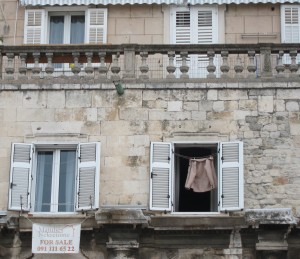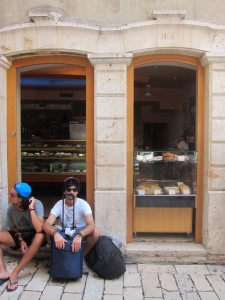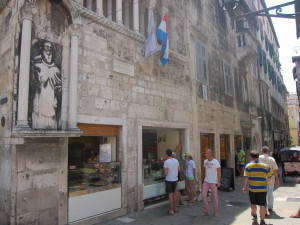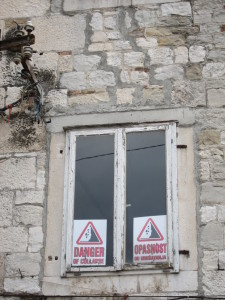The Financial Times proclaimed the ancient Palace in Split the most desirable living place in a competition among 182 urban localities from UNESCO’s list of world heritage sites. But wealthier inhabitants do not reside here because they value the privilege of living in the most preserved Roman palace in the world; they have recognised its commercial potential. The new occasional residents are tourists and the city centre is adjusting to their needs
By Barbara Matejčić
Croatian version
The view from the window evokes Split’s inhabitants favourite saying “No money can buy this” meaning that the Mediterranean climate and ambiance they live in are priceless. Some twenty meters straight ahead is a small port; bigger ships in the main port are in the background; the Riva (Waterfront) right under the window with palm trees and neatly arranged Mediterranean gardens; a long promenade extends from the Riva, right up to the marina and the forest of white masts under the hill Sustipan; to the right is the greenery of the parkforest Marjan, the island of Šolta in the distance and lots and lots of sea. Next to the window, indented in the over 1700-year-old walls of the Diocletian Palace, is a small chair without backrest. “That’s my place for morning coffee,” says a lady in her sixties. She’s been living in this apartment with a view since she was born – her family was accommodated here after WWII along with another family. But the view has a price: 800.000 euros. That’s the asking price for the 131 square meters where these two families live. The space has since been divided into two apartments with a joint entrance, but they’ve decided to sell together making this piece of prime real estate more interesting to potential buyers. The lady says that it’ll be hard for her to move, but as she has three adult children, selling the place is the only way for her to make it possible for them to live independently in a less expensive part of city.

Probably only a foreigner will have the means to shell out such an amount. The real estate agency, through which I came to see the apartment, is oriented exclusively towards foreign markets. In this same building three apartments have already been sold to foreigners who went on to remodel them into suites and are now renting them out for anywhere between 150 to 300 euros per day. In a good tourism year just one of these suites, at an average price of 200 euros per day, can rake in around 25,000 euros. And the past couple of years have been consistently good in Split.

The heart of Split’s old town was the least desirable place to live in for years on end due to poor living conditions. Split, a city with a population of 178,000 and capital of Dalmatian region in Croatia, was formed in the early middle ages within a monumental palace built by the Roman emperor Diocletian in the early 4th century. The palace’s value and preservation, as well as longtime continuity of life within it, were the reason that UNESCO included it in its list of world heritage sites as far back as 1979.
From the late 19th century almost anyone who could, moved out of the city centre, while only those who had no alternative moved into the congested, uncomfortable, often unhygienic quarters built at various times within the Palace. Following WWII, welfare cases were accommodated in nationalised apartments, often several families within the same apartment. During the 1980s, the south part of Diocletian’s Palace, the so-called Ghetto, was a dark area cloaked in the smell of urine, with junky needles strewn all about the archaeological sites, which one avoided even during a daytime. Today, Split’s most expensive apartments are located here. In April 2012 The Financial Times proclaimed the ancient Palace the most desirable living place in a competition among 182 urban localities from UNESCO’s list of world heritage sites.
However, apartments within the Palace aren’t bought for active living, rather for profit. Wealthier inhabitants do not reside here because they value the privilege of living in the most preserved Roman palace in the world; the ones who come here are those who have recognised its commercial potential.
Asked about the future of Diocletian’s palace Split’s current mayor Željko Kerum, stated six years ago, when he was among the major city entrepreneurs: “I entertained the idea of offering citizens living in the city centre 400 replacement apartments (…), and have the ancient premises converted into a tourism business. The old city core needs to be neater and illuminated like Dubrovnik, which would represent a foundation for the development of tourism. I think that the city government should exercise its right of real estate pre-emption, as the investment could be paid off in a short period and one could live off the rent alone.”

His vision is now unintentionally coming to fruition. The increase of real estate is too enticing for old residents to resist the temptation to sell, while new, local residents can’t afford it. According to the data from the last two censuses the old city core lost a third of its residents. In 2001 there were 2882 inhabitants, while ten years later the number dropped to 2036. The new occasional residents are tourists and the city centre is adjusting to their needs.
“We’re like commandos. We have to fight to stay living in the centre,” says Mislav Čalo. We met in front of the one-time café ‘Automat’ in the Pjaca, the main city square. The café where those who worked in the centre socialise on a regular basis was replaced by a store with expensive clothes. It’s now empty, the shop window covered with white paper. Right next to it is a loud, orange-red painted building ‘Palace Suites’, which advertises itself with a neon sign on its façade, normally prohibited in the old centre. On the Internet pages, views of the Iron Door, the west entrance to the Diocletian’s Palace, are advertised to guests, along with gothic, renaissance and romanesque architectural monuments and – “numerous lively cafes.” That is correct. During the summer, the Pjaca is loaded with terraces of cafés and restaurants, as are numerous Split squares often beyond the 50% that is legal for public spaces to be leased. Mislav lives near the Pjaca and during the summer decides between one of the two entrances into the little street where his apartment is. One entrance is usually blocked by a café, and the other with a stench of urine, garbage and vomit from those who get drunk and throw up, possibly from one of those pub crawls organised for young tourists. We’re passing by the Ciprijan de Ciprijanis Palace built in the 14th century. There was a bookstore for decades, now is a fast food joint that looks and smells like a fifth-rate McDonalds.
Grocery stores, clockmakers, cobblers, butchers, lawyers were replaced by endless restaurants, cafés, souvenir shops, commercial galleries and fast food venues. There is no plan to determine which businesses will be opened in the old town, no limit set on the number of restaurants, coffee bars or holiday apartments, as well as no incentive for opening businesses with a different purpose. Businesses which would be important for the few remaining residents as well as for maintaining the function of the Split city centre. There is the institution of protected purpose but even the City officials in charge of it, if asked, are not able to bring to mind more than two such places: a bookstore at the main square Pjaca and an old pharmacy. This year so far 1.9 million euros has been collected from leases on public surfaces in the entire city, 50 per cent of which goes to public surfaces in the very centre, we are informed in the Department for municipal services. However there is no obligation for a part of the funds generated by the old town to be reinvested in it.
These places intended for tourists are mostly closed from November to April. It’s seven in the evening and the city is virtually empty. We arrive at Peristil, the ancient square and main tourist attraction where dance evenings are held during the summer, along with Dalmatian harmony-singing. A ceremonious performance of Verdi’s ‘Aida’ is regularly staged here on summer nights as well. All is quiet now. Peristil glistens with the whiteness of renovated stone, an investment of four million euros. “In the historical core only the most important monuments are renovated. These renovations are slow and too expensive, while nobody cares about the residential houses and infrastructure. Investments in the infrastructure haven’t been made in decades so when thousands of tourists invade the city, the sewage and water system are facing a collapse. Tenants are obliged to renovate the buildings they live in but there is no available subsidy for these expensive works that have to be carried out according to preservation rules. People can’t afford that. So it’s simpler to just sell and move out”, says Čalo. All business venues within the old city centre are obligated to pay monumental rent. That alone raked in 1.5 million euros in 2010, from which 40% goes to the State, while 60% remains for the City. Čalo says that it isn’t transparent what that money is spent on, but that it is certainly not invested in the city’s infrastructure. The association of residents of the historical core called “Genius loci”, which Čalo is a member of, formulated an investment programme where part of the monument rent should be put aside for housing so that the less fortunate residents could have an advantage. They sent their programme proposal to the Ministry of Culture and are awaiting an answer.

“City officials aren’t doing anything to keep the residents in the centre, while Diocletian’s Palace would never be what it is if it was not for the fact that people continue to live in it. Without this ‘life infusion’, it would have ended up just like all other ancient monuments – in ruins“, says Čalo. Only those buildings where tourism related businesses are placed are being renovated, so there will, in effect, be no ruins, but the Palace could end up as one big apartment with all these tourism attractions that have been spreading like wildfire for the past few years – the Diocletian Guard, gladiators, medieval pirates kidnapping the Roman empress – enfolded in the scent of baked oil. An ancient Disneyland of sorts.
Foreign interest for real estate in the centre of Split emerged in the late 1990s. It started with people working in Split, in the Peace Corps and other international organisations, who recognised the value of the derelict apartments in the Palace. They bought them at a price of 1000 euro per square meter, renovated them and rented them out.
“I estimate that around 250 and 350 properties have already been sold in the city centre. The pinnacle of dealing was in late 2007 when apartments well selling at 3000 euros per square meter on average, with prices escalating up to 7000 euros for the south side of the Palace. Before the financial crisis foreigners were buying up apartments as an investment, while today this is a way to ‘bank’ their money, they think it’s the best way to preserve their money. Lately, Croatians that have been living abroad have also started buying prime real estate, and they also buy with the aim to rent, maybe spending the odd week themselves in the place during the summer. Nobody buys in order to live in the centre,” says real estate agent Ivo Perković.
Parallel with the increase of interest for real estate in the centre, interest in tourism started blooming in Split. Tourists came before, but mostly ‘en passant’, seeing Split only as the main port in Dalmatia connecting the mainland with numerous islands. However, during the last few years Split became a destination as opposed to its being a mere transitory place.
“Where else would you find a Roman palace two thousand years old with such a bustling everyday life? Simply breathtaking! So much more enjoyable than what you see when visiting ancient sites in places like Rome and Athens. In this case, the palace is not only historically significant, it also still serves as a place where people live, work, shop and dine,” a visitors enthuse on Internet sites such as TripAdvisor.
“The Mediterranean is a strong tourist destination. And Split’s advantage is to be on the peaceful part of the Mediterranean in the recent years as opposed to, unfortunately, nowadays Greece or Northern African countries. Split provides a good entwinement of city content with numerous beaches and clear seas and has good transport connections. The global decrease in travel and accommodation expenses increased the mobility of travellers, especially that of young people who come to Split in droves. However, the increased number of guests is also a result of the promotional efforts of the Tourist Board”, explains Lidija Petrić, Head of the study programme ‘Tourism’ at the Faculty of Economics in Split.
By mid-November this year 309.860 tourists had visited Split, while ten years earlier, during the entire 2002, the number amounted to 106.807. A whopping 87 % includes foreign guests, who stay for three days on average. In 2007 the guest accommodation capacity consisted of 5750 beds in various accommodations – hotels, suites, rooms. Only two hostels were in existence in whole Split back then. This year, there are 24 hostels registered in Split, according to the data of the Split Tourist Information Centre, while the whole accommodation capacity climbed to 11.488 beds. It’s double of what it was only 5 years ago. The majority of hotels, hostels and private renters are situated in the city core.
Split became an obligatory stop in Mediterranean cruiser routes. Just in the course of one day, five cruisers are known to dock in the port, which amounts to approximately 12,000 people being released unto the narrow streets of the city. It is estimated that 273 cruisers are set to visit Split by the end of this year, while 232 are already registered for next year, according to the Split Port Authority. New docks are also planned for large ships, although no consensus was reached as to whether such a large number of visitors is necessary for Split and whether it is even cost effective considering that these are mainly day guests who do not spend much. As studies on the number of tourists and accommodation capacities are non-existent.
“Split has neither strategically broached the subject of tourism development within the City nor has it set any limits upon visitor increase i.e. determining what its incoming accommodation capacities are, in socio-economic, ecological and spatial terms. There are various measures that can be directed towards the development of tourism and towards decreasing the pressure on the city, such as limiting the growth of accommodation capacities, limiting the number of cruisers and charging ecology tax for cruisers. However, as Split does not have an articulated concept of tourism development, many decisions are brought without a clear vision of its future,” says Lidija Petrić.
However, Split is at least moving in the direction of having a management plan for the old city centre. That is, a plan is already in existence, formulated by the Israeli architect Giora Solar, a leader within the International Council for Monuments and Sites (ICOMOS). Solar earned 133 thousand euros for this direct order from the former city authorities, while the plan never saw the light of day. The City Council did not adopt it due to numerous criticisms it got from the general public. The primary resentment being that it is much too generalised and treats the historical centre as a monument to be milked for money, while neglecting the social dimensions of the space. The plan also did not take the residents’ needs into account nor did it deal with the issue as to how best preserve life in the old town centre. In early 2012, a Committee was formed to formulate a draft proposal of a Plan for managing the historical centre of Split, which started working immediately. This Committee includes representatives of the City, the Ministry of Culture, conservators, scientists, representatives of organisations. This team of 33 people should bring guidelines and shed some light on the issue of revitalization of the historical centre of Split.
The borders of the historical centre which are under UNESCO protection also present a problem. Srđan Marinić from the Society of Cultural Heritage Split holds that the borders are being manipulated due to investment operations in Split’s most sensitive area. In the beginning of this year, the conservators increased the zone of strictest protection in one area, while decreased it in another. It is as yet unknown why, but Split activists tend to err on the side of caution hence they alerted UNESCO. As the remodelling of the Riva has been a stumbling point for some time now, as the Riva is also a protected site, as well as the development plan for a large residential-business complex in the protected centre, UNESCO received hundreds of warnings of concerned citizens. The public still is not informed about the UNESCO’s conclusion, but unconfirmed information circulated that Split could very well be removed from UNESCO’s list. This would be a huge blow to the city, among other things because the prestigious UNESCO list is a tourist magnet. UNESCO is in contact with the Ministry of Culture due to this issue, thus we asked Minister Zlatko Uzelac to comment.
“UNESCO made serious inquiries into numerous citizens’ complaints and decided that Split would not be taken off the UNESCO list. There was a possibility that Split would be the main subject of UNESCO’s general assembly, but that in the end that didn’t happen either,” stated Uzelac.
In the very heart of the Palace, there is but one last remaining old tavern ‘Dioklecijan’. The owner Ante Prkić opened it 41 years ago, when only two cafes existed within the Palace. Today is the first time he is considering to close up tavern during the winter as he’s barely making ends meet. While we chat in the interior that has not been changed in years, we are surrounded by people who are on strike over unpaid salaries in a construction company. In the past twenty years almost all larger companies closed down or drastically reduced number of workers – primarily due to the collapse of the Yugoslav market and deindustrialisation, followed by badly executed privatisation and lastly due to the economic crisis. Split is the centre of the County that has the largest unemployment rate in Croatia – 13.4 %.
“If it weren’t for tourism, we all might as well just throw ourselves into the sea,” says Ante Prkić. This is the first year since he opened his tavern in 1971 that he is considering about closing it. “It’s not cost-effective for me to be open all year round, as the locals who used to be my regular guests aren’t around anymore. I used to sell three, four prosciutto hams on a daily basis, while now, one lasts ten days. The only reason I haven’t already closed the place down is because of my waitresses who are over 50 years old and if I let them go, they’ll lose their job. Who will hire them then?” says Prkić.
Two young people joined in our conversation. One of them rents out holiday apartments and rooms belonging to residents who during summer temporarily move from their apartments in order to earn some money, but do not speak foreign languages nor use the internet competently enough to rent on their own. This is his livelihood. The other one is Marin Krpetić, resident of the nearby small Alješijeva street, one of the rare ones in which the renovation of the infrastructure carried out last winter was paid by the City authorities. Prkić openly accused the authorities of engaging in repair only because an Italian investor bought apartments there. In the building where Marin lives only his family is left. All of the other apartments have been turned into holiday apartments. “People sold them because they were in dire straits”, he says. Real estate agents started knocking on his door too ten years ago already. The first ones to come were individuals and later came the off shore companies. He says he didn’t want to leave the Palace because it was the home to his “childhood and pride”. The street has been spruced up with hanging and floor flower pots. Marin says that’s everything they got from foreign investors, and no one even consulted the locals on the matter. “If people had jobs and were paid regularly they wouldn’t be selling the only thing they’ve got. Now they’re forced to sell everything but the clothes on their back. Tourism is necessary evil“, he concludes.

“Dalmatia is set to transform into a land of chefs, waiters and whores,” Meri Berticioli quotes the lyrics of a local singer, while we stroll during the next night along the Palace by which she Her family used to hold the renowned grocery store “Bonačić” at the beginning of the century, in the building they live in today. The store has long closed and a ‘Diesel’ store is there in its place. Meri is a lawyer, 30 years old and lives with her parents. As opposed to many who leave their apartments during the summer months to make money off renting them, they make nothing from tourism. She’s aware of the fact that, when she decides to move away, she’ll most probably live somewhere outside the Palace. “Many people with whom I grew up with on these stony streets went to live in the suburbs, as they couldn’t afford to live in this same neighbourhood once they moved out of their parent’s places. And normal life as we knew it is slowly but surely slipping away here. The crowds become unbearable during the summer months, while the city is asleep during the winter. If people stop living in the Palace, tourists will also be less inclined to visit the museum like city centre,” she says. We joke that the city authorities will then probably come up with some sort of model for people to simulate life within the Palace just for the tourists’ sake. “In the morning when we wake up we’ll all punch a card like we came to work and then we’ll turn on Dalmatian music on the radio and hang around at our windows, just to make it that much more authentic,” laughs Meri.

On Saturday, a day later, I pass through the part of the Palace which used to be called Kenjara (Shithole). This is now the home to the new Ethnographic Museum, a furbished rectory of the Cathedral of Saint Domnius built on the location of Diocletian’s mausoleum and houses with blue plates advertising holiday apartments and rooms for rent. On the pillars along the south wall of Diocletian’s Palace there is a graffiti reading “I hate this town”. The word “love” is written over the word “hate” in pencil. One of the houses along the eastern wall of Diocletian’s Palace looks like it is about to tumble down any minute. As if nothing around it has changed. A woman is peeking through small plastic window blinds. I ask her if there is a chance that the City will repair this rundown little house and the walls which are crumbling. She looks at me as if I asked the stupidest question possible and before disappearing mumbles “What City?” I go down to the Riva (Waterfront) through the old, main town market, which seems to be growing smaller each day. Saleswomen say they bring vegetables in twice a week instead of every day as before, because people either don’t have the money to buy it or they go to the big stores outside the city centre. On Riva I look at a “For sale” sign hanging from a window on the Diocletian’s walls and I try to figure out if this is the window with a 800 thousand euro view. I gaze at the sea on a mild, sunny November day and I get the urge to say: “No money can buy this.”
